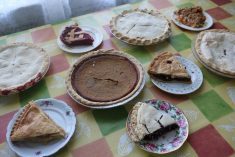After a hard day working in the fields, the farm families of the 1920s had no time or money to drive to the nearest town to seek entertainment.
They would make their own fun. Gathering around the piano or the radio, the leisure activities were often a family occasion. Sometimes the children played board games while the adults read newspapers or books.
For special occasions that included young and old, the community came together at the church summer picnic, the school Christmas pageant, wedding dances and harvest potluck suppers.
Read Also

Accurate accounting, inventory records are important
Maintaining detailed accounting and inventory records is not just a best practice; it’s a critical component of financial health, operational efficiency and compliance with programs like AgriStability.
From the early days of the Western Producer comes an advertisement offering bargain prices for used pianos for prairie homes. The Saskatoon Music Co. Ltd. had models ranging from $175-$500 that needed to be cleared out for a new shipment of instruments.
Not all the leisure was meant for the home. In the Sept. 9, 1926 issue there is an ad that said “No hall, church or school need be without a motion picture entertainment this coming fall and winter.” Regina Films Ltd. was offering to sell projectors and films as the only manufacturer and distributor in Saskatchewan.
The Producer’s “Mainly for Women” pages, edited by Violet MacNaughton, often carried news of family recreation. In the Sept. 16, 1926 issue she discussed games children play. She remarked that “childhood on the prairie is too barren anyway – too little encouragement is given to the development of the imagination. Too many examples of the ‘acquisitive instinct’ are exhibited to children.”
She cited an example from a woman she had met who had organized a sports day for the young folk of the community. This woman had made up coloured ribbons for the winners of various races.
“As the children lined up for the first race a small boy asked: ‘What is the prize?’ The lady showed the ribbons but the youngsters refused to run saying ‘we’ll run for 10 cents but not for that.’ And the sports were called off.”
Mrs. Mac carried on her discussion the following week noting that “those games or sports are always to be preferred which cultivate the accurate use of eye, ear and hand, rather than those which rely on chance or luck for their interest.”
Following a meeting with the United Farmers of Canada that asked the paper to supply more news of interest to women and children, the Producer started carrying a page listing of daily radio programs for stations across the West and into the United States. It proved to be a popular page with the readers and the advertisers and the listings continued for two decades.
Another novelty that became common in the pages was a mystery story that ran as a serial. The first fiction piece started in Nov. 25, 1926. On March 10, 1927, the paper started what it called a junior page with cooking, jokes, games and written submissions by children and teens. It was a forerunner to the Young Co-operators pages that continued in the paper until the late 1990s.
In her Jan. 13, 1927 column, Mrs. Mac asked to hear about community libraries. She wrote that “in spite of overwork, in spite of radio and other possible distractions, the art of reading continues to develop…. There are however, still many places without adequate reading facilities.”
In a response, a reader from Tompkins, Sask., noted that the local women’s branch of the Grain Growers had set up a library three years before.
“We pay our librarian $5 a month and she keeps open certain hours two days a week…. Some of our members found it hard to spare the dollar membership fee so we accepted two or three books in lieu of the money. Children under 15 pay 25 cents a year. We now have over 400 books in our library.”
In the April 21, 1927 issue, the Producer carried an ad for a new device – the telephone. Northern Electric telephone said farmers could “use the phone for profit by keeping in touch with market prices.” But it also noted the phone is “a source of protection and pleasure.”
Later that summer Mrs. Mac was bemoaning the lack of rural participation at the Saskatchewan Music Festival.
She said, “What is the moral? That we wake up as farm dwellers and recognize that we are here not only to make a living but to live a life and that our economic program shall demand food and clothing for mind as well as body.”
Over the next 15 years the youth pages expanded into the rigorous path that Mrs. Mac urged. Alongside the more serious pursuits of sewing and embroidery patterns, there were song lyrics, book reviews and penpals.
By 1940 there was also a regular sports page in the Producer giving baseball and hockey standings from Canada and the U.S., as well as short snippets of provincial and regional team games. The Saskatchewan Wheat Pool used to sponsor hockey broadcasts over local radio stations.
Common social activities for 4-H clubs were square dancing and curling bonspiels. And baseball tournaments beckoned. In the June 5, 1941 issue, there was a discussion of hobbies.
One 13 year old wrote in about her old habit of collecting glass and broken bits of china.
“These I carefully put into tin cans and stored them away in my playhouse. For hours I amused myself playing with the various pieces of glass. Sometimes I would make mud pies and place some of the fancy pieces on top for decoration. But as I grew older the novelty of my hobby wore off and one day, I still don’t know why, I took all the cans to the garbage fields and dumped all the pieces of glass there. They are still there and whenever I see them, pleasant memories of my childhood come back to me.”
Other junior writers remembered hockey games and skating carnivals. One 17-year-old boy wrote about his first broomball game, saying, “the game looked so slow that when someone handed me a broom I stepped on to the ice confidently. After a seemingly endless skirmish at the far end, the ball came rolling towards me. Happily I took a swing at it. Imagine my surprise when it spun around and sailed neatly into our goal. I had scored!”
A letter war between the sexes broke out on the pages in April 1941. Here is one from Trixie Belle of Windthorst, Sask.:
“How about boys? Today they don’t think a dance is complete without making a trip to the beer parlour, and if he happens to have a car, his girl is wondering if she’ll ever arrive home safely.
“Talk about girls doing nothing. Just look at some of the town boys. They sit on the doorstep of their father’s store without budging an inch all day to go in and help him.”
In June 1941, Prairie Yodeller, 17, of Moreland, Sask., recounted her local sports day.
“Our local town girls asked me to pitch for them so I hurried downtown, donned one of the girl’s ball togs and started warming up. We played two games. Won the first by thewide margin of 26 to 6. We lost the second nearly as badly, 9to 19. But I was really in the seventh heaven out there on the pitcher’s mound amid shouts of ‘the pitcher’s in the air’ and ‘Oh look, she’s going to town now.’ …
“After our games we watched the men’s baseball and kiddies races. I would really have liked to race, too, but it was under 12 so I was excluded. (Continued)
“In the evening they had a dance but as I was grimy and dirty from playing ball and lived away out on the farm, I went home to milk my faithful oldcows.
“When the clock said 10:15, I yawned and said ‘bedtime.’ “
Two decades later the rage was curling. The women’s section had a pattern for knitting a curling sweater, bonspiel photos were running regularly and the paper explained the proper way to flood an ice rink.
The sports page reported that Ernie Richardson, Canadian and international curling champion for the past two years, was eliminated in the competition for the Saskatchewan 1961 champ. The Brier was won that year by Hec Gervais of Edmonton.
Recreation was becoming a family or individual activity, rather than a community based one. Most people had cars and could travel for leisure activities. In May 1961, the Producer ran a vacation calendar listing fairs, horse races, football games and golf tournaments for the summer in each of the four western provinces.
A June 1, 1961 article lamented a problem of summer leisure – that “exuberant over the return of balmy weather, many boys take to the country with their rifles, ostensibly to do some target shooting. Too often the targets turn out to be migratory birds or public or private property.”
Another article that summer said: “Clean, well-equipped campgrounds are beginning to dot the roadsides. Now, finding a spot to pitch the tent as the evening shadows begin to lengthen is no longer a problem. Some of the campgrounds are even equipped with power…. Remember to keep it simple by keeping the gear down to a minimum. Dad wants to have a little rest and relaxation too. He does not want to spend the whole time packing and unpacking a lot of unnecessary equipment.”
Two decades later, camping had evolved into large RVs and motor homes that rumbled south as grain-farming snowbirds fled the approach of winter. Fishing and golf came to dominate recreation in summer.
For those farmers who stayed at home in winter, and who weren’t tuned in to their satellite TVs, it was hockey, with parents driving kilometres every weekend for kids’ tournaments. Hockey rivalry even spilled over into the local economy and caused many an argument between neighbouring towns.
As the century ended, snowmobiling and ice fishing were growing in popularity.
Meanwhile computers, once tools for business, had changed the isolation of the farm as children and adults climbed onto the worldwide web.














